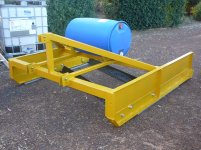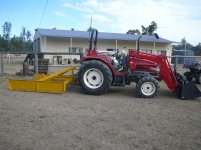What kind of design is needed to get the best job from one of these. I've seen wheels, no wheels, wheels extended longer distances, ...etc. I have a JD 314 I'm using with a landplane inside a 3' box blade. I'm not satified with the job it does. It seems to follow the ground contour too much. Would gauge wheels help? If so where should they be located? How about overall length?
You are using an out of date browser. It may not display this or other websites correctly.
You should upgrade or use an alternative browser.
You should upgrade or use an alternative browser.
3 pt hitch Land Leveler??
- Thread starter sos1
- Start date
/ 3 pt hitch Land Leveler??
#1
Army grunt
Platinum Member
Its the 3 ft box ,It is not wide enough to do anything but follow the ground, Try simply adding a new cutting edge thats wider.just a thought.
Army Grunt
Army Grunt
Not sure what this is... Got a photo of it?...a landplane inside a 3' box blade...
MtnViewRanch
Elite Member, Advertiser
- Joined
- Mar 19, 2005
- Messages
- 10,456
- Tractor
- Mahindra 7520, Mahindra 3215HST, Case 580 extendahoe, Case 310 dozer, Parsons trencher, Cat D6,
Research has led me to the thought that a floating top link should correct the problem. I'm also going to add 12" to the width to make 48".
I think that a floating top link is going to allow your implement to roll forward and you may not get the result that you are looking for. Maybe try it very slow without a top link at all and you will see what I'm talking about.
I agree with teg, a picture of what you're working with would be nice also. You know what they say, a picture is worth a thousand words.
SGBotsford
Bronze Member
Any method of leveling needs to have a mechanism to average the heights of various points.
Category 1: 3PH full lift. (Only supported by the 3PH) You are cutting at a level determined by the tractor wheels. There are two issues with this:
1. If the ground is bumpy, then when the front wheels go up, the implement bites deeper. If the distance between bumps is wrong, you can actually magnify the bumps. This is how washboards form on gravel roads.
2. Tractors run fairly low pressure in their tires. The tractor tilts to the outside of corners, and to the downhill side of hills.
Answer: Make your first pass so that it is contact with the ground only 10-20% of the time. As you get it more level, you can take off longer slices.
Category 2: 3PH with gauge wheels. Now it's the back wheels of the tractor and the gauge wheels that determine the cutting point. A lot of the time, the gauge wheels are near the cutting edge. This is fine for gopher hills, but doesn't work if the bumps are wider than the blade. It also doesn't work well for long swells (A 6" high bump spread out over 12 feet.
Ideally you want gauge wheels that are several feet behind the blade. And the blade should be half way between the tractor wheels and the gauge wheels.
Category 2b Drags.
One common form of tool that uses this principle is the common drag. Multiple blades on a frame that is tractor wide, and 10 to whatever feet long. Ignoring individual gravel, the drag is touching the ground in only 3 points. (Ever try to get a 4 legged table to sit right on a bumpy lawn...) At those points it's taking material off. The three points will be different from second to second. A drag only takes the highest spots off -- and only bumps that fit between the sections. But a drag can move at high speed, so having to go over the land several times is not a big deal.
Category 3. Active blade positioning. These are much longer, much more expensive units that position the blade with hydraulics depending on the flex where it couples to the tractor. The blade mirrors the relative motion of the front wheels. If the wheels rise, the tractor is coming out of a dip, the blade raises some to let more material spill.
Category 4. Laser /GPS leveling. A rotating laser is used to establish a plane. A sensor mast rides above the blade, and continuously adjusts the blade. Couple this with differential GPS and you have the landscape version of a numerical control milling machine. This sort of precision is useful if you are setting up pasture for flood irrigation, and you want a constant 1 foot per 100 feet slope over a 40 acre field.
Category 1: 3PH full lift. (Only supported by the 3PH) You are cutting at a level determined by the tractor wheels. There are two issues with this:
1. If the ground is bumpy, then when the front wheels go up, the implement bites deeper. If the distance between bumps is wrong, you can actually magnify the bumps. This is how washboards form on gravel roads.
2. Tractors run fairly low pressure in their tires. The tractor tilts to the outside of corners, and to the downhill side of hills.
Answer: Make your first pass so that it is contact with the ground only 10-20% of the time. As you get it more level, you can take off longer slices.
Category 2: 3PH with gauge wheels. Now it's the back wheels of the tractor and the gauge wheels that determine the cutting point. A lot of the time, the gauge wheels are near the cutting edge. This is fine for gopher hills, but doesn't work if the bumps are wider than the blade. It also doesn't work well for long swells (A 6" high bump spread out over 12 feet.
Ideally you want gauge wheels that are several feet behind the blade. And the blade should be half way between the tractor wheels and the gauge wheels.
Category 2b Drags.
One common form of tool that uses this principle is the common drag. Multiple blades on a frame that is tractor wide, and 10 to whatever feet long. Ignoring individual gravel, the drag is touching the ground in only 3 points. (Ever try to get a 4 legged table to sit right on a bumpy lawn...) At those points it's taking material off. The three points will be different from second to second. A drag only takes the highest spots off -- and only bumps that fit between the sections. But a drag can move at high speed, so having to go over the land several times is not a big deal.
Category 3. Active blade positioning. These are much longer, much more expensive units that position the blade with hydraulics depending on the flex where it couples to the tractor. The blade mirrors the relative motion of the front wheels. If the wheels rise, the tractor is coming out of a dip, the blade raises some to let more material spill.
Category 4. Laser /GPS leveling. A rotating laser is used to establish a plane. A sensor mast rides above the blade, and continuously adjusts the blade. Couple this with differential GPS and you have the landscape version of a numerical control milling machine. This sort of precision is useful if you are setting up pasture for flood irrigation, and you want a constant 1 foot per 100 feet slope over a 40 acre field.
jenkinsph
Super Star Member
SGB,
I am trying to set up a pull type boxblade with a laser. Looking to go with two receivers with auto machine control and proportional valves. Any experience with this?
I am trying to set up a pull type boxblade with a laser. Looking to go with two receivers with auto machine control and proportional valves. Any experience with this?
john40981
Silver Member
- Joined
- Feb 18, 2013
- Messages
- 120
- Location
- Dalby QLD
- Tractor
- Yanmar EF685 with 4in1 loader, Yanmar YM2700 with 4in1 loader, Fiat AT7C Dozer
A land plain is much easier to use and gives better results in most cases if you just want to level ground.
A floting top link on your box blade I think will just make your box blade lift up at the back. I was going to do that with my land plain which is 8' long and a lot heavier than a box blade and it still lifted the back.


http://www.tractorbynet.com/forums/build-yourself/287452-land-plain-blade-height-help.html
A floting top link on your box blade I think will just make your box blade lift up at the back. I was going to do that with my land plain which is 8' long and a lot heavier than a box blade and it still lifted the back.


http://www.tractorbynet.com/forums/build-yourself/287452-land-plain-blade-height-help.html
Renze
Elite Member
Here is a thread on Farmphoto of 2004, when i ploughed, leveled and reseeded a hay field. It shows our neighbours land drag we use, and how i worked with it.
It is made of I beams and you can adjust the agressivity by lengthening the top link. On soft ground you adjust it so that the front 2 beams skim the high spots, and only the rear beam really drags.
You normally fill the holes first, if the ground is too hard you lenghten the top link so the rear I beam bites good with its lower flange, and after the rough work is done you smooth it with the top link pin shaking in the hole (not the full weight on the implement) and also with a long toplink, so it semi-slides on the I beam flange.
re-seeding a hay field - Page 1 [#91015 / 99919]
It is made of I beams and you can adjust the agressivity by lengthening the top link. On soft ground you adjust it so that the front 2 beams skim the high spots, and only the rear beam really drags.
You normally fill the holes first, if the ground is too hard you lenghten the top link so the rear I beam bites good with its lower flange, and after the rough work is done you smooth it with the top link pin shaking in the hole (not the full weight on the implement) and also with a long toplink, so it semi-slides on the I beam flange.
re-seeding a hay field - Page 1 [#91015 / 99919]